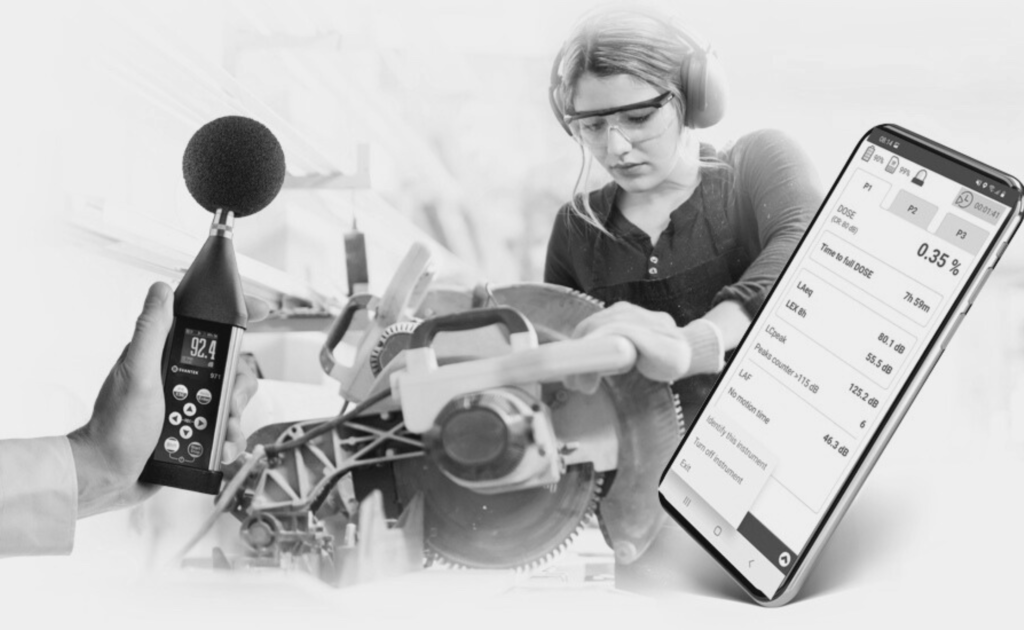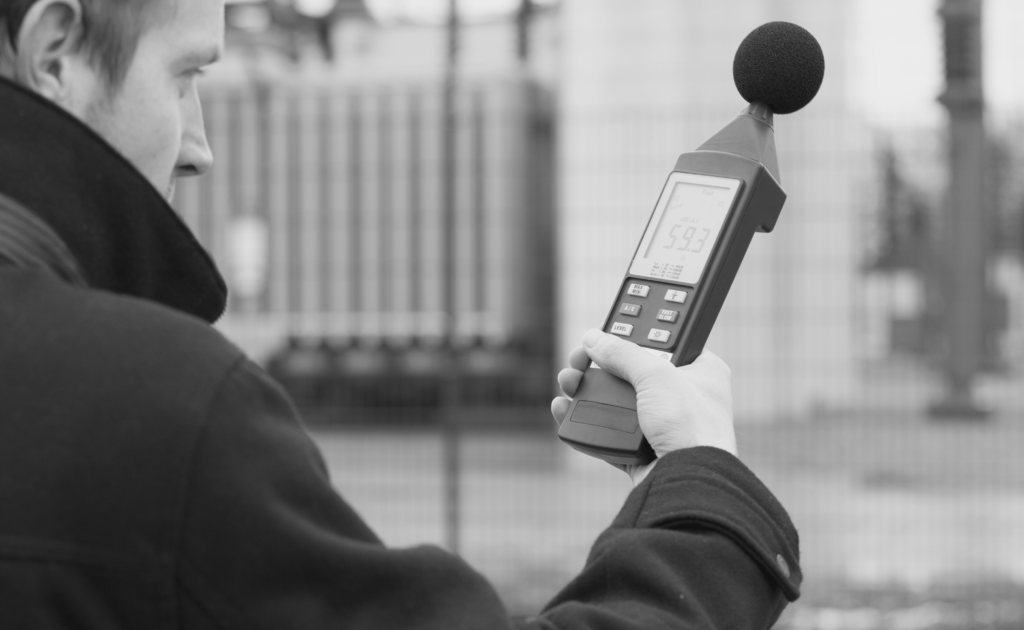
In the intricate tapestry of occupational safety, health, and environmental protection, the quest for precision echoes louder than ever. For industries such as pharmaceuticals, chemicals, petrochemicals, automotive, rubber, glass, pulp and paper, utilities, mining, steel, and more, achieving global safety compliance requires not just compliance but mastery. In this effort, a fundamental element appears at the intersection of technology and meticulousness: sound measurement – acoustic calibrators.
The importance of sound measurement resonates across vast landscapes, influencing regulations, workplace conditions, and the well-being of individuals in diverse industries. Sound measurement is the foundation of safe operations, whether protecting workers from hazardous noise, assessing the impact of noise on the environment, or ensuring product quality through acoustic evaluation. However, achieving accuracy and consistency requires the right tools and the calibration accuracy to back them up.
Enter the unsung heroes of this endeavor: acoustic calibrators. These unassuming yet indispensable devices are crucial to unlocking the reliability and validity of sound measurements. In a world where decibels dictate safety boundaries, acoustic calibrators emerge as beacons of precision – a critical tool for those seeking unwavering accuracy.
This discourse embarks on an illuminating journey into sound measurement, anchored by the quintessential role of acoustic calibrators. A beacon for international manufacturers, government agencies, environmental protection organizations, and distributors alike, this exploration reveals the intricate mechanisms of these devices and their far-reaching impact on global safety compliance.
As we delve into the intricacies of this topic, we aim to unravel the technical complexities, decipher the terminologies, and present an informed perspective that resonates with professionals across the spectrum.
Join us on a journey where every decibel matters, every nuance counts, and every instrument – every calibrator – is a testament to the meticulous dedication we collectively invest in pursuing global safety compliance through the lens of sound measurement.
Acoustic calibrators the guardians of sound measurement accuracy
In the meticulous world of sound measurement, where accuracy holds safety scales, an unsung tool emerges that silently ensures the integrity of every recorded decibel – the acoustic calibrator. As we delve into the intricacies of precision sound measurement, the spotlight naturally falls on these unassuming yet indispensable devices. Bridging science, technology, and compliance, acoustic calibrators are the true guardians of sound measurement accuracy.
For manufacturers navigating the labyrinthine pathways of global markets where industries such as pharmaceuticals, chemicals, petrochemicals, automotive, rubber, glass, pulp, utilities, mining, and steel converge, the role of accurate sound measurement is paramount. Government institutions share this quest for precision with their passionate commitment to occupational safety and environmental agencies charged with monitoring noise pollution. Ministries of health and universities are training the next generation of experts who are united in their need for unwavering accuracy in sound measurement.
At the heart of this quest is the acoustic calibrator, a sophisticated yet indispensable tool designed to provide a known reference sound level. A subtle blend of mechanics and precision, acoustic calibrators are the cornerstone of proper measurement accuracy. They calibrate good level meters, microphones, and a spectrum of acoustic measurement equipment, ensuring that their readings are accurate and consistent.
What sets acoustic calibrators apart is their role in bridging the gap between theoretical and actual sound measurement. With them, the uncertainty often shrouds sound measurement disappears, replaced by a known reference good level. This meticulously performed calibration process transforms acoustic measurement devices into reliable sentinels, guarding against inaccuracies compromising safety assessments, compliance evaluations, and environmental impact studies.
While the technical nuances of acoustic calibrators may seem arcane, their impact is far-reaching. From the bustling floors of industrial facilities to the serene environments of educational institutions, acoustic calibrators stand as steadfast allies, ensuring that sound measurement data is a testament to accuracy. Their importance reverberates through industries, resonates with professionals, and aligns seamlessly with the quest for global safety compliance.
In the following chapters, we unravel the intricacies of acoustic calibrators, exploring how they work, their types and classifications, and their central role in occupational health. Our journey together will navigate the technical terrain with clarity and enrich your understanding of the accuracy of sound measurement – a pursuit that shapes industries, informs policy and ultimately contributes to a safer, more harmonious world.
Mastering the basics of acoustic calibrators: ensuring accurate sound measurements
When you delve into the fundamental aspects of acoustic calibrators, where precision reigns supreme, understanding them isn’t just informative – it’s essential. As we navigate the maze of technologies that support occupational safety, health, and environmental protection, the role of these unassuming devices emerges as a beacon of accuracy and consistency.
The journey to accurate sound measurement begins with calibration, a process in which acoustic calibrators’ known reference sound level becomes the guiding star. These meticulously engineered instruments generate a precise sound wave at specific frequencies and pressure levels. This reference sound level is the benchmark against which other acoustic measurement equipment is evaluated.
Acoustic calibrators come in several types, each tailored to specific measurement scenarios. They unite the mechanisms they employ in their quest for accuracy, from piston-driven calibrators to electroacoustic and electrodynamic counterparts. Whether hand-held or panel-mounted, their design is a testament to the engineering finesse required for precise sound-level output.
International Electrotechnical Commission (IEC) standards provide a structured classification of acoustic calibrators to ensure their accuracy meets global standards. From acoustic calibrators Class 0, which represents the pinnacle of accuracy, to Class 4, each category offers a distinct level of preciseness. Manufacturers, institutions, and professionals use these classifications to select the appropriate acoustic calibrator.
In the realm of occupational health, where the effects of noise exposure reverberate throughout industries, acoustic calibrators shine as guardians of compliance; their precision ensures that sound level meters and other acoustic instruments provide readings that are not only reliable but actionable. This reliability influences the implementation of hearing conservation measures and the formulation of safety protocols that protect workers’ well-being.
Mastering the basics of acoustic calibrators goes beyond the technical. It equips pharmaceuticals, chemicals, petrochemicals, automotive, rubber, glass, pulp and paper, utilities, mining, steel, and more professionals with the fundamental knowledge to improve their decision-making. It’s about enabling governments, institutions, and environmental consultants to weave precision into their noise monitoring efforts.
The intricate interplay of science, technology, and meticulous calibration elevates sound measurement from an elusive art to an attainable science. With each revelation, we get closer to the heart of precise sound measurement – a quest that resonates with industries, maintains compliance, and ultimately fosters a safer, more harmonious world.

The diversity of acoustic calibrators: Types and applications explored
The spotlight of sound measurement precision turns to the diverse array of acoustic calibrators that grace the landscape. These meticulously crafted instruments, each with its own unique design and purpose, navigate an intricate maze with finesse and accuracy. In this chapter, we will explore the types and applications of acoustic calibrators, highlighting their specialized role in the pursuit of global safety compliance.
- Pistonphone calibrators: At the heart of acoustic calibrator diversity is the pistonphone calibrator handheld marvel that uses mechanical precision to generate a known sound pressure level. These calibrators are the first choice for calibrating microphones and group meters using a piston-driven mechanism. Their versatility makes them indispensable in fields where meticulous calibration is paramount.
- Sound level meter calibrators: Specialized calibrators come to the fore for those venturing into the world of good level meters. They are designed to meet accuracy requirements. They ensure that these instruments provide readings that reflect real-world sound levels. As essential components of sound level meter calibration, they facilitate the generation of reliable data in various environments.
- Electroacoustic calibrators: The realm of electronic precision welcomes electroacoustic calibrators, which use electrical signals to synthesize a known sound pressure level. Their ability to calibrate microphones, sound level meters, and other acoustic measurement devices electronically demonstrates the fusion of technology and accuracy. Electroacoustic calibrators excel in environments that require intricate control.
- Electrodynamic calibrators: Like their electroacoustic counterparts, they generate reference sound levels with electrical mechanisms. However, their unique loudspeaker-like approach sets them apart and makes them invaluable for calibrating microphones and sound level meters. The harmonious interplay of technology and acoustics resonates throughout their design and application.
- Combination calibrators: These calibrators offer a versatile solution in a world of versatility. These instruments elegantly combine different types of calibrators in a single unit to calibrate multiple acoustic measurement devices. The combination of functions simplifies the calibration process, increasing efficiency and accuracy.
As the types of acoustic calibrators expand, so do their applications across industries. Their role extends from the pharmaceutical laboratory to the automotive production floor and beyond. Government institutions, environmental agencies, and universities rely on their accuracy to support noise assessments and environmental impact studies.
In our quest for precision in sound measurement, the diversity of acoustic calibrators creates a complex mosaic of technologies, applications, and solutions. Each type
Decoding the IEC classification to ensure sound measurement accuracy
The accuracy and reliability of acoustic calibrators are paramount. These inconspicuous yet intricate devices are the foundation for ensuring consistent and reliable sound measurements across multiple industries and applications. As we venture further into the technical landscape, our focus shifts to deciphering the International Electrotechnical Commission (IEC) classification for acoustic calibrators – an endeavor that adds a new layer of sophistication to the pursuit of sound measurement accuracy.
As international safety, health, and environmental (SH&E) instrument manufacturers are looking to enter or expand into global markets, the IEC classification is emerging as a guiding star. This standard, ranging from Class 0 to Class 4, becomes the compass that guides the selection of acoustic calibrators tailored to specific accuracy requirements.
As international manufacturers, institutions, and distributors strive to navigate the intricate path of sound measurement accuracy, the IEC Classification for Acoustic Calibrators emerges as the thread that weaves accuracy and compliance. It enables decision-makers to make informed choices based on the specific requirements of their industries and applications. The IEC classification bridges the technical intricacies of acoustic measurement and the broader landscape of occupational health, safety, and environmental protection.
As we move forward, our exploration of the IEC Classification for Acoustic Calibrators will delve deeper into the nuances of each class, highlighting its technical significance and practical applications. From the lab to the factory floor, from the labs of educational institutions to the corridors of government agencies, understanding the IEC classification translates into actionable insights that take sound measurement accuracy to new heights.

An insight into IEC classification: From class 0 to class 4 acoustic calibrators
Understanding the nuances of this classification is paramount for international manufacturers venturing into occupational safety, health, and environmental protection. Let’s unravel the differences between Class 0 and Class 4 acoustic calibrators, each representing the many shades of accuracy.
- Class 0 Acoustic Calibrators: Class 0 acoustic calibrators exemplify unwavering accuracy at the pinnacle of precision. Tailored for pharmaceutical, petrochemical, and automotive industries, where the margin for error is minimal, Class 0 calibrators are beacons of reliability. Government agencies charged with environmental assessments and universities conducting in-depth research find comfort in the precision of these calibrators. When sound measurement accuracy is non-negotiable, Class 0 is the resolute choice.
- Class 1 and Class 2: As our exploration continues, Class 1 and Class 2 acoustic calibrators come into focus, offering a delicate balance between accuracy and versatility. Industries that require careful calibration of sound level meters, personal noise dosimeters, and microphones find their needs met in Class 1 and Class 2. From sectors as diverse as steel and utilities to the corridors of academia, these calibrators carve out a niche by balancing accuracy with practicality.
- Class 3 and Class 4: Class 3 and Class 4 acoustic calibrators step up to the plate for rough inspections and essential maintenance. While they may have a different precision than their higher-class counterparts, these calibrators serve a critical purpose. They become tools for routine field calibrations and provide a safety net for industries that require baseline assessments. When real-time accuracy takes a back seat to rapid evaluation, Class 3 and Class 4 calibrators offer an invaluable service.
The IEC classification becomes the intersection of need and precision for international manufacturers. The gradations from Class 0 to Class 4 offer a spectrum of options to meet the needs of industries, institutions, and organizations seeking to maintain global safety compliance. Whether the goal is the highest levels of accuracy or practical assessments for compliance, the IEC classification guides choices that reverberate through industries as diverse as pharmaceuticals, chemicals, automotive, and more.
We follow a path toward informed decision-making as we explore the IEC classification for acoustic calibrators. Each class represents a different facet of accuracy, and as international manufacturers, institutions, and distributors strive to excel in their respective fields, understanding these gradations becomes a compass. The pursuit of sound measurement accuracy is not just about technicalities; it’s about charting a course that meets the intricate needs of industries, upholds global safety standards, and shapes a world where precision reigns supreme.
Acoustic calibrators in occupational health: safeguarding workers from hazardous noise
As international manufacturers looking to enter or expand in global markets set their sights on protecting workers in various industries, the role of acoustic calibrators comes to the forefront. Let’s take a deep dive into the world of precision, where sophisticated technology intersects with the well-being of workers, all under the banner of sonic measurement accuracy.
Worker health is imperative in the diverse fields of pharmaceuticals, chemicals, petrochemicals, and beyond. The dangers of hazardous noise reverberate across industries, threatening the auditory well-being of workers and posing long-term risks. As governments, institutions, and manufacturers unite to mitigate these hazards, the importance of accurate sound measurement grows.
Workers are expected to be exposed to excessive noise levels that require more than just routine assessments; they need measurements that stand up to scrutiny and protect their well-being. Acoustic calibrators, meticulously calibrated and traceable to international standards, become the bridge between compliance and precision. They turn mere measurements into actionable insights that enable industries to implement effective noise control measures and protect workers.
As international manufacturers navigate the complexities of global markets, the role of acoustic measurement accuracy stands as a guiding principle, a testament to their commitment to precision, compliance, and the protection of those who drive our industries.

Empowering occupational health: the role of acoustic calibrators in noise hazard mitigation
The well-being of workers is of paramount importance. The value of accurate sound measurement cannot be balanced, and the intricate complexities of hazardous noise exposure draw our attention to the acoustic calibrator. This unassuming device takes center stage in occupational health settings, where precision becomes the cornerstone of noise hazard mitigation.
As we know, prevention is the cornerstone of worker well-being. Hazardous noise exposure, prevalent in industries ranging from petrochemical to automotive, requires meticulous attention to detail. This is where acoustic calibrators come in. Calibrated to the most stringent standards, these instruments provide a reference sound level that becomes the touchstone for accurate sound measurement. They provide the basis for informed decisions that enable industries to assess noise levels, implement appropriate controls, and ultimately prevent the risks associated with excessive noise.
By placing calibration equipment in proximity to the acoustic calibrator and comparing readings, industries gain insight into the accuracy of the equipment. This process becomes a cornerstone of noise hazard mitigation, enabling data-driven decisions that protect workers’ hearing health.
The role of acoustic calibrators transcends industry boundaries to provide a unified approach to worker well-being. From steel to utilities, calibrating sound level meters, microphones, and personal noise dosimeters have become critical.
Government agencies charged with occupational health mandates and universities conducting in-depth research rely on these instruments to ensure the accuracy of sound measurements. This unified approach underscores the importance of acoustic calibrators as protective tools across multiple sectors.
Through their unwavering accuracy, these instruments forge a path where precision and prevention converge. As industries strive to reduce the risks of hazardous noise exposure, acoustic calibrators stand as allies in the pursuit of worker safety. The journey to protect workers from hazardous noise exposure finds its compass in the meticulous accuracy of these instruments – a testament to the dedication to precision and the relentless commitment of those who drive our industries forward.
Visit our blog about occupational safety and health administration to learn more.
Conclusion
As we understand the challenges of occupational safety, health, and environmental protection, the pursuit of precision in sound measurement is a resounding imperative. Across industries, the importance of accurate sound measurement resonates deeply. This pursuit ensures compliance and signifies mastery in protecting worker well-being and environmental harmony.
At the heart of this effort is a silent but essential hero – the acoustic calibrator. Meticulously designed and calibrated, these unassuming devices are the guardians of sound measurement accuracy. They bridge the gap between theory and reality, transforming acoustic measurement equipment into reliable sentinels that protect against inaccuracies compromising safety assessments, compliance evaluations, and environmental impact studies.
From the heights of Class 0 acoustic calibrators that exemplify the highest precision to the practicality of Class 4 calibrators for routine field evaluations, the International Electrotechnical Commission (IEC) classification guides manufacturers and decision-makers to the appropriate tools for their needs. These classifications reflect the diverse needs of industries and ensure precision that resonates from the laboratory to the factory floor.
The journey to sound measurement accuracy, anchored by acoustic calibrators, is a journey of science, technology, and meticulous calibration. It’s a journey that weaves through industries, shapes policy and promotes a safer, more harmonious world. As the echoes of precision reverberate, these unassuming instruments stand tall, ensuring that every decibel matters, every nuance counts, and every device – every calibrator – contributes to the meticulous dedication invested in achieving global safety compliance through the lens of sound measurement.
